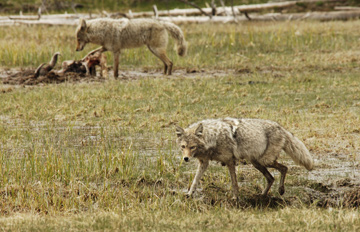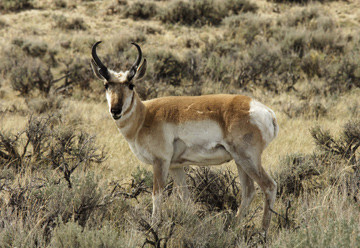Fewer wolves may mean fewer pronghorn in Yellowstone
Fewer wolves may mean fewer pronghorn in Yellowstone
WCS
March 3, 2008
|
|
As western states debate removing the gray wolf from protection under the Endangered Species Act, a new study by the Wildlife Conservation Society cautions that doing so may result in an unintended decline in another species: the pronghorn, a uniquely North American animal that resembles an African antelope.
The study, appearing in the latest issue of the journal Ecology, says that fewer wolves mean more coyotes, which can prey heavily on pronghorn fawns if the delicate balance between predators and their prey is altered. According to the study, healthy wolf packs keep coyote numbers in check, while rarely feeding on pronghorn fawns themselves. As a result, fawns have higher survival rates when wolves are present in an ecosystem.
“People tend to think that more wolves always mean fewer prey,” said WCS researcher Dr. Kim Berger, lead author of the study. “But in this case, wolves are so much bigger than coyotes that it doesn’t make sense for them to waste time searching for pronghorn fawns. It would be like trying to feed an entire family on a single Big Mac.”
  Coyotes and pronghorns in Yellowstone. Julie Larsen Maher/Wildlife Conservation Society Jack rabbits vanish from Yellowstone, ecologists puzzled February 14, 2008 Scientists are puzzled over the apparent disappearance of jack rabbits from Grand Teton and Yellowstone National Parks, but say the local extinction may be having region-wide impacts on a variety of other prey species and their predators, according to a new study by the Bronx Zoo-based Wildlife Conservation Society. Wolves push out coyotes in wilderness areas September 11, 2007 Coyote densities are more than 30 percent lower in areas they share with wolves, according to a paper published in the most recent edition of the Journal of Animal Ecology. The results show that wolves limit the range and number of coyotes in an area. |
Over a three-year period, researchers radio-collared more than 100 fawns in wolf-free and wolf-abundant areas of Grand Teton National Park and monitored their survival throughout the summer. The results showed that only 10 percent of fawns survived in areas lacking wolves, but where coyote densities were higher. In areas where wolves were abundant, 34 percent of pronghorn fawns survived. Wolves reduce coyote numbers by killing them outright or by causing them to shift to safer areas of the Park not utilized by wolves.
While pronghorn are not endangered, the population that summers in Grand Teton National Park, part of the Greater Yellowstone Ecosystem, had been reduced to fewer than 200 animals in recent years. Since wolves were reintroduced in 1995, the pronghorn population in Grand Teton has increased by approximately 50 percent. These pronghorn have the longest migration — more than 200 miles roundtrip — of any land mammal in the lower 48 states. The Wildlife Conservation Society has called for permanent protection of their migration corridor, known as “Path of the Pronghorn,” to prevent the animals from going extinct in the Park. Representatives from the National Park Service, U.S. Fish and Wildlife Service, and U.S. Forest Service recently pledged support for protecting the corridor.
If delisting occurs, Wyoming and Idaho have announced their intention to reduce wolf number by 50 percent and 80 percent, respectively. At present, there are an estimated 300 wolves in Wyoming and 700 in Idaho.
“This study shows just how complex relationships between predators and their prey can be,” said Berger. “It’s an important reminder that we often don’t understand ecosystems nearly as well as we think we do, and that our efforts to manipulate them can have unexpected consequences.”